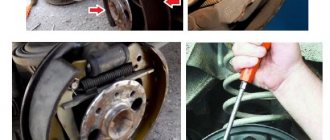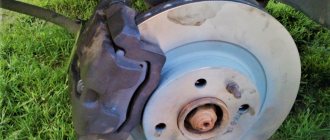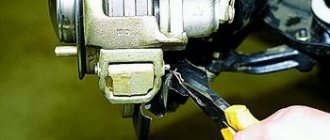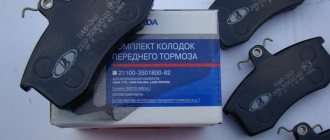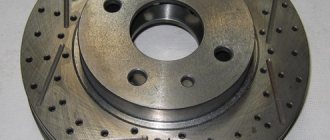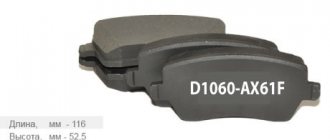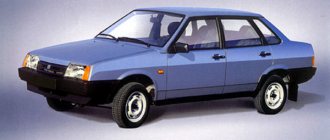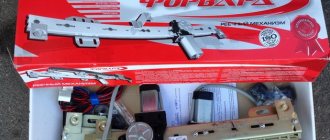The pads also need to be replaced if the linings are oily, have deep grooves and chips on them, or if the linings are detached from the base of the pads.
We carry out the work on a flat area, inspection ditch or overpass.
Attention!
The brake pads of the rear wheels must be replaced as a set - all four pads. Replacing the pads of only one brake mechanism can lead to the car pulling to the side when braking.
We show replacing the pads on the right rear wheel. Before removing the brake drum, lower the parking cable lever all the way - the car must be released.
We remove the rear wheel and securely fix the car on a factory-made support stand.
To remove the drum, the pads must be brought together.
2283-14-03-01
To do this, use a slotted screwdriver to rotate the ratcheting nut of the mechanism for automatically adjusting the gap between the pads and the drum through the threaded hole in the brake drum, thereby reducing the length of the spacer bar.
To do this, use a slotted screwdriver to rotate the ratcheting nut of the mechanism for automatically adjusting the gap between the pads and the drum through the threaded hole in the brake drum, thereby reducing the length of the spacer bar.
Device
The unit consists of the following parts:
- The Lada Vesta brake drum with a bearing and an ABS ring is mounted on the rear pillar axle. The body of the part has four threaded holes for fastening the wheel. It has a cylindrical shape and is cast from cast iron. The inner surface is carefully processed to eliminate roughness.
- The pads are semicircular in shape, with a diameter 2 mm smaller relative to the inner diameter of the drum. Friction linings are attached to the outer sides. The upper part of the pads is connected to the brake cylinder, and the lower part touches the mechanical stop.
- The cylinder has two pistons that extend in opposite directions.
- The ABS system contains 2 elements - a speed sensor and an impulse rotor (a metal toothed ring). The sensor is attached to the wheel stand guard. The rotor is pressed onto the outside of the drum bearing.
- The spacer bar consists of a threaded rod that screws into a hollow tube. A ratchet wheel is pressed onto the surface of the tube.
- The upper coil spring returns the pads to their original state after removing the force from the brake pedal. The lower spring maintains constant pressure on the lower ends of the pads against the stopper.
Photo source: https://www.drive2.com/l/530431348347765662/
Knowing the design of the node, you can understand the causes of its problems and quickly fix them.
DSC_9324
Elements of the rear wheel brake mechanism.
Elements of the rear wheel brake mechanism.
The mechanism for automatically adjusting the gap between the shoes and the drum is made in the form of a composite spacer bar.
When you press the brake pedal, under the action of the pistons of the wheel cylinder, the pads begin to diverge and press against the drum, while the protrusion of the adjuster lever moves along the cavity between the teeth of the ratchet nut. When the pads are worn to a certain level and the brake pedal is pressed, the adjuster lever has enough travel to turn the ratchet nut by one tooth, thereby increasing the length of the spacer bar and at the same time reducing the gap between the pads and the drum. Thus, the gradual lengthening of the spacer bar automatically maintains the gap between the brake drum and the shoes. The same system maintains the parking brake in constantly working condition without any adjustments.
What can you tell by the wear of the rear brake pads?
Pad wear means:
- Wear of the friction layer;
- Damage to the friction layer (for example, cracks);
- Friction layer bevel;
- Carbon deposits on the discs or drum.
These “illnesses” can appear when:
- Light knocking sound when braking. This should not be confused with ABS;
- Poor braking efficiency;
- Whistling, grinding noise when braking;
- Dust, chips on the discs.
Any car repair operation is a treatment. But a separate operation may not be a treatment, but a concealment of the symptoms of a real disease. If consumables are changed due to their “natural death” - the mileage mark has simply reached 60,000 km, then other parts of the mechanism clearly should not be blamed for this.
But if the consumables failed earlier, then replacing them may not solve the problem, and soon you may have to change not only them, but also other parts of the mechanism. This is due to another malfunction in the mechanism:
- Insufficient brake fluid level;
- Caliper malfunction (causes uneven wear of the friction layer), insufficient amount of lubricant or unsuitable lubricant;
- Faulty guides (for example, damaged boot);
- Incorrect adjustment of the service brake system, failure to release the handbrake;
- Low quality friction layer;
- Damage to oil seals;
- Depressurization (airing) of the mechanism;
- Uneven operation of hydraulic cylinders supplying unequal forces;
- Brake hose leak;
- ABS jamming;
- Warped brake disc.
DSC_9301
The spacer bar is a rather complex mechanism, which, if the elements are damaged or significantly corroded, is best replaced.
If the condition of the spacer bar is satisfactory, then it should be washed in any solvent and a thin layer of grease should be applied to the threads. The spacer bar is a rather complex mechanism, which, if the elements are damaged or significantly corroded, is best replaced. If the condition of the spacer bar is satisfactory, then it should be washed in any solvent and a thin layer of grease should be applied to the threads.
Additional security systems on Lada Vesta
In addition to the main braking mechanism, designed to control the car by the driver pressing the pedal or using the handbrake, the AvtoVAZ car has a number of adaptive electronic devices:
- ABS – prevents wheel locking during emergency braking;
- HSA – assistance when starting off and driving on an incline;
- TCS is a traction control device that helps overcome light off-road conditions without slipping, distributing torque to the wheel depending on its load;
- ESC - exchange rate stability system controls the behavior of the car in a skid, thanks to which the car maintains the specified trajectory;
- EBD is a braking force distribution device that allows you to apply different forces and influence the speed of stopping.
Considering all these innovations on the Lada Vesta, paired with good braking elements, they can prevent any emergency situation on the road related to the stability and control of the car.
DSC_9303
Before assembly, completely screw in the rear end of the spacer bar so that its length becomes minimal.
Before assembly, completely screw in the rear end of the spacer bar so that its length becomes minimal.
Install new rear wheel brake pads in reverse order.
Before installing the brake drum, clean its working surface with a wire brush to remove dirt and wear products from the pads.
Main differences between disc and drum
The braking mechanism consists of several parts and differs in two types of design.
The disk unit has an open design, allowing the device to operate for a long time without overheating. When you press the brake pedal, the brake pads are pressed against the disc mounted inside the wheel rim using a caliper. The degree of compression of the disc by the calipers is very high, which allows the car to brake more efficiently. As a result of heavy loads, the mechanism has a relatively short resource.
The drum mechanism has a closed cylindrical body, which prevents the entry of dirt and dust and has a long working life. The brake pads are pressed against the inner surface of the drum, causing the car to stop. The pressing force of the elements is comparatively lower than that of analogues with a disk, therefore such mechanisms are considered less effective.
The combination of front discs and rear drums is optimal in terms of efficiency and durability. This version of the Lada Vesta justifies itself with its reasonable price and reliability.
DSC_9261 (Copy)
When cleaning the brake drum, be careful with the ABS sensor reference ring.
When cleaning the brake drum, be careful with the ABS sensor reference ring.
After installing the brake drum, tighten the hub bearing nut to the prescribed torque of 175 N∙m.
It is advisable to install a new self-locking nut. On the left wheel this requirement is more critical than on the right.
Similarly, we replace the brake pads of the right wheel.
We check the brake fluid level in the hydraulic drive system reservoir and, if necessary, bring it to normal.
To adjust the position of the brake pads, press the brake pedal several times. We hold it down and then raise and lower the parking brake (when moving the lever, you must keep the parking brake release button on the lever depressed at all times so that the ratchet mechanism does not work). In this case, clicks will be heard in the brake mechanisms of the rear wheels from the operation of the mechanism for automatically adjusting the gaps between the pads and brake drums. We raise and lower the parking brake lever until the clicking in the brake mechanisms stops.
If necessary, adjust the parking brake.
Basic faults
If we exclude the possible defective parts and poor quality from the manufacturer, then the main reason why the front pads on the Lada Vesta become unusable is wear. They actively interact with other parts of the brake mechanism, and therefore a look at the nature of damage to the friction linings will make it clear what is wrong with the operation of the brake system. By correcting this error, you will increase the service life of not only the pads, but also the entire mechanism.
The nature of the malfunctions can be noted:
- Uniform wear - it manifests itself in the fact that the friction layer is worn evenly, this shows that the brakes are working well.
- Severe wear of the friction layer, brake rivets are visible - this means that you have been using the “outdated” parts for too long. The rivets could damage the disc, so it would be a good idea to inspect it for damage.
- The friction layer is worn evenly around the entire circle, but one of the sides is worn out more than the other - one of the parts of the brake system (guide or piston) does not distribute the braking force correctly. Cleaning all “live” parts and applying a new layer of lubricant will help. Naturally, everything will have to change.
- Both components are worn unevenly, the surface is strewn with irregularities and roughness. The reason for this outcome is a malfunction of the caliper guide pins - they swing and do not give an even trajectory of movement. You will have to clean them, then reapply lubricant.
- The friction lining is cracked - in this case, the “trouble” is caused by the brake discs themselves - they wear unevenly. Everything will have to change.
- Uneven wear of the friction layer means that the parts were installed incorrectly. They will have to be changed.
After performing a visual inspection of the damage, you can independently make a verdict about the breakdown. And besides this, there are several other signs by which you can find out about a faulty front pad while sitting behind the wheel.
Creak
If a squeaking noise occurs from the front when braking, this means that the pad and disc are not mating. This happens when a cheap analogue was purchased to replace the original component. But not everything is so bad - sometimes this analogue can last a long time, but the real reason is dirt that has gotten into the moving parts and reduces the contact area of the moving parts.
Vibration at speed: what is it?
Vibration at speed appears when the pads do not fit the discs - there is some incompatibility that does not manifest itself in the operation of the “original” parts. If, when braking, you still get “full contact” of these parts of the brake mechanism, this means that the wear of the hub discs themselves is haunting, and they will have to be replaced.
Repair price
Service stations estimate replacement of drum system pads at 1,400 rubles. The pads are changed on both sides at once, having been purchased in advance.
The Vesta factory installs FORD pads (article 1433865) at a price of 2,735 rubles. Non-original parts are suitable, they are cheaper, but the quality may be worse.
The factory uses the brake drum for Vesta with article number 432008333R. If wear on the inner surface exceeds acceptable limits, it is replaced. A Lada Vesta drum with ABS costs 7,000 rubles, replacement – 600 rubles.
Replacing a unit by service station employees costs 2,000 rubles. Car enthusiasts do this work themselves. Drums for Vesta can be purchased at a car store.
